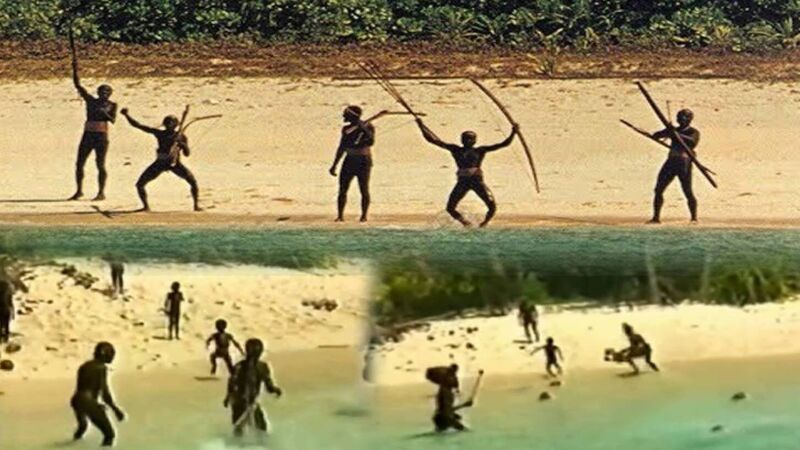Damien Enright: Sentinelese are the experts at self-isolating

North Sentinelese islanders on a remote tribe off India. They have no contact with the tribes of other islands and their language is unknown and unclassifiable.
We marvel at the instinct of wild creatures. Humans have instinctive reactions, too. A casebook example is the rejection of any contact with the modern world by the only Palaeolithic tribe surviving on earth.
Right or wrong, they have chosen isolation for millennia. They are the last humans on earth to remain virtually untouched by modern civilisation.
The Sentinelese tribe are the indigenous inhabitants of North Sentinel Island in the Andaman Islands in the Bay of Bengal. They protect themselves violently from contact with 'civilisation'. The reaction can only be instinctive as they have no experience of it.
Lost tribes are not discovered these days; it seems that there are none left to be found. Anthropologists say that of 238 Amazonian tribes contacted in the last decade 75% are now extinct, and only 20% of the remaining tribes survive.
Do the North Sentinelese islanders know of this statistic — is this why they want no part of our world?
No: no media reaches the island. They have no contact with the tribes of other islands. Sentinelese is the language of an uncontacted people. It is unknown and is unclassifiable.
The Sentinelese resist all attempts by authorities and anthropologists to study their culture. Believed to number anywhere from 50 to 400, DNA studies indicate that the tribe has lived in isolation for 70,000 years. They originated in Africa and migrated to India through Indonesia.
North Sentinel has an area of 60km (26 miles), is almost circular, ringed by white sand beaches and shallow reefs, and has a centre of dense forest. Little else is known about it or its people other than that they are extremely hostile and never leave their island. They resist all attempts by authorities and anthropologists to study their culture.
Apart from seeing ships passing on the horizon, and huge aircraft passing in the stratosphere overhead, they can know nothing of the outside world. They kill anyone who lands on their shores.
In 2006, two Indian fishermen, in trouble at sea, went ashore. They were attacked and killed by tribesmen wielding bows and arrows. An Indian coastguard helicopter attempting to retrieve the bodies was greeted by hails of arrows, and could not land.
The Indian government has achieved some minimal contact. The sea area is patrolled by the Indian navy. The Andaman and Nicobar Islands Protection of Aboriginal Tribes Act prohibits any approach closer than five nautical miles (9.26 km) in order to prevent the tribespeople from contracting diseases to which they have no immunity.
In November 2018, an American adventure tourist claiming to be a missionary was illegally ferried to within reach of North Sentinel by fishermen, and then canoed himself ashore. He was killed on the beach. Authorities, fearing that the body might harbour diseases to which the Sentinelese would have no immunity, attempted recovery. After several attempts involving tense encounters with the tribe, they were forced to abandon their efforts.
The Indian authorities do not try to prosecute the islanders for killing intruders. They recognise the islanders' desire to be left alone, and restrict their role to remote monitoring. Violent response has marked attempts at contact by outsiders over the centuries. Such responses have probably saved them from extinction.
While the current policy attempts to preserve the Andaman and Nicobar islanders' culture, in the past other island tribes did not succeed in self-isolating. Most now face extinction. The Great Andamanese tribe, numbering several thousand in the 18th century, were decimated by colonialists during the period of the British Raj in India. Currently less than 100 survive. Opium and alcohol was sponsored by the colonial authorities as a means of decimating the tribes, including the Jarawas, the earliest settlers of the Andamans, said to be the first tribe to leave Africa.
The Sentinelese islanders' diet consists mainly of coconuts and fish caught in shallow waters. Based on observational data, they are hunter-gatherers; agriculture is not known to them. Their meat consists of turtles and small birds. The only modern artifacts are their arrow tips, made from steel salvaged from wrecks.
In December 2004, the monster tsunami that struck the Bay of Bengal was feared to have drowned many islanders, who would have had no warning. However, uncannily, the tribe had moved to high ground before its arrival. Anthropologists believe that ancient knowledge of the movement of wind, sea and birds may have saved it and tribes on other islands.
"They can smell the wind. They can gauge the depth of the sea with the sound of their paddles. They have a sixth sense which we don't possess," said Ashish Roy, a local environmentalist and lawyer who has called on the courts to protect the tribes by preventing their contact with the outside world.










